Geology | Plants | Fungi | Mammals | Birds | Amphibians | Species list
The Opal Creek Wilderness and the neighboring Bull of the Woods Wilderness comprise the largest contiguous area of low-elevation old growth left in Oregon. Opal Creek's ancient rainforest is a remnant of the conifer forests that once stretched from the Pacific coast to the crest of the Cascades, and from southeast Alaska to the northwest corner of California. This region, also known as Cascadia, contains trees and other organisms uniquely adapted to the heavy rainfall—70-100 inches per year--including the most diverse moss species of anywhere in the world.
Geology
30 million years ago, Jawbone Flats would have been surrounded by huge conical volcanic peaks and mounded shield volcanoes studded with cinder cones, covered in verdant tropical and subtropical rainforest. The scene would have been reminiscent of the volcanic highlands of Costa Rica today. These peaks were part of the West Cascades mountain chain, a mountain range that existed before our modern Cascades. The West Cascades chain erupted and eroded in innumerable cycles from 37 million years ago to 7.4 million years ago, when the volcanic center shifted east to its modern-day position. In the intervening millions of years, the West Cascades were eroded by water and flowing glacial ice, until all you see today are rounded, heavily-forested ridges, the remnants of stratovolcanoes.
Relatively recently in geologic time, the Pleistocene era began about 2 million years ago, perhaps better known as one of many ice ages. Glaciers reached down from Canada into the northern latitudes of the United States, advancing and retreating in cycles as the climate cooled and warmed in succession. One of these glaciers, unable to penetrate the warmer low elevations of the Opal Creek area, scooped out a basin high up on a ridge 15,000 years ago, which filled with water as the glaciers retreated, and became the headwaters of Opal Creek.
For several thousand years the climate entered a relatively warm, dry period, and the forests of the Cascades were filled with drought- and fire-tolerant species. After this brief interlude, the climate once again shifted and became cool and wet. It was at this time that the mega-conifers that make up today’s ancient forests slowly migrated into the Pacific Northwest from more northern forests, following the cooling climate south.
Plants
At an elevation of 2,200 feet, the town of Jawbone Flats is surrounded by an ancient forest. Hiking Opal Creek trails you’ll find giant, old trees; standing dead trees which provide habitat for birds, bats, small mammals, and insects; fallen trees on the forest floor that return nutrients to the soil with the help of decomposing fungi and insects; and layers in the forest canopy which provide pockets of light for younger trees to grow. All of these are essential components of an old-growth forest.
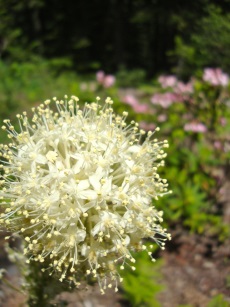
Beargrass in bloom. Photo credit: Mark Cornwell
The oldest dated tree at Opal Creek is the Douglas fir (Pseudotsuga menziesii), and one of the largest known is “Guts Gibbs,” measured to be over 270 feet high and 1,000 years old! Growing in its shade are the Western hemlock (Tsuga heterophylla) and the Western red cedar (Thuja plicata). Opal Creek is often called a “late successional forest” because many of the hemlocks and cedars are beginning to overtake the Douglas firs in height and abundance, as the firs age and fall to the forest floor. Below these giants you will find our fourth conifer, the Pacific yew (Taxus brevifolia). The Pacific yew is an extremely slow-growing shade-tolerant tree; a tree that may appear to be 50 years old could be well over 200!
Many plants thrive in our moist temperate rainforest, with 9 months of precipitation and a short 3-month summer drought. The understory is rich with many species of shrubs, ferns, wildflowers, and berries. The forest floor is blanketed with bryophytes (non-vascular plants like mosses, liverworts, and hornworts), making a lush green carpet that cradles the giant old trees. Bryophytes make up a large percentage of old-growth canopy by growing on tree branches, where they are known as epiphytes (plants that take in nutrients from the air, rain, and debris around them rather than the soil). When it rains, canopy epiphytes absorb and hold up to 30% of the precipitation in the atmosphere. The moisture is released later as occult precipitation. After a rain, you may notice fog lifting from the mountain ridges; this is occult precipitation in action!
Fungi
The rainforests of the Pacific Northwest are ideal habitat for fungi, and they play an integral part in the rainforest ecosystem. Many fungi are saprophytic, decomposing dead plant matter and returning valuable nutrients to the soil. Others are parasitic, taking nutrients from living trees and other plant hosts. Still others are mycorrhizal, forming a symbiotic relationship with trees by attaching their thread-like filaments, called hyphae, to tree roots. This creates a large underground network in which the hyphae transfer nutrients and water to the tree roots in exchange for food in the form of glucose. In the Opal Creek Wilderness, 90% of all plants form this relationship with fungi, and all trees are mycorrhizal!
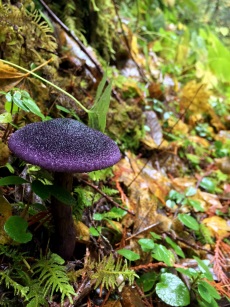
Violet cortinarius mushroom.
Mushrooms are the fruiting bodies of the fungi; when you see a mushroom in the forest, you are seeing the equivalent of an apple on a tree. The most prolific season for mushrooms is the rainy autumn. Common fall mushrooms at Opal Creek are: chicken of the woods, chanterelle, bolete, russula, milk cap, cauliflower, coral, honey mushroom, lobster, and puffball. A few species of mushrooms continue to fruit throughout the winter, such as winter chanterelles and hedgehog mushrooms. Springtime morels round out the mushroom fruiting season.
Fungi are an entire kingdom of organisms that includes mushrooms, lichens, and molds. Scientists estimate that there are approximately 1.5 million species of fungi in the world, and only 5% are named! At Opal Creek we have identified over 165 species of fungi, but there are many more to discover.
Lichen
Lichens are a fascinating and unique organism that are actually composed of multiple organisms interacting to help each other survive. This is known as a mutualistic symbiotic relationship. Lichens consist of algae and fungus, and sometimes cyanobacteria (also known as blue-green algae) and yeast.
The algae perform photosynthesis in which it captures light energy from the sun and converts it to chemical energy in the form of sugar (glucose). The associated fungus uses the glucose to grow more of its body. In exchange, the fungus is able to provide a protective home in which the algae lives. The fungus also uses its body like a sponge, absorbing nutrients and water from the atmosphere and precipitation, some of which is taken up by the algae in exchange for more glucose.
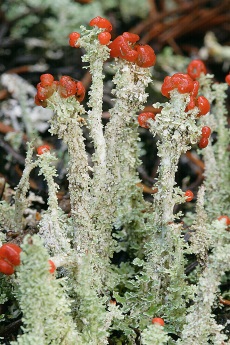
Cladonia bellidiflora lichen. Photo credit: Martin Hutten
Some lichen, especially in the Pacific Northwest, have a third partner living and working to help the symbiotic organism survive. This partner is cyanobacteria (blue-green algae) and not only photosynthesizes, but also fixes nitrogen. Most nitrogen found in nature is composed of such strong chemical bonds that most organisms cannot use it. However, cyanobacteria can break up the nitrogen, allowing it to be used by the fungus and the algae within the lichen. At Opal Creek, lichen perform a critical function by returning this nitrogen to the soil when they decay, providing trees and plants with an important nutrient.
There are close to 14,000 lichen species worldwide, 1,000 of which exist in the Pacific Northwest, with 150 of those right here in the Opal Creek Wilderness! Many lichen are extremely sensitive to air pollution, so the health and diversity of our lichen community is a key indicator of the pristine air quality at Opal Creek.
For an in-depth exploration of lichens and their role in the old-growth ecosystem, check out our every-other-year workshop Mosses, Lichens, and Liverworts.
Mammals
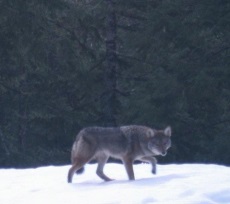
This coyote was caught by our camera trap in the winter of 2012.
Many mammals of various sizes live in the Opal Creek Wilderness. The megafauna are largely elusive, preferring to stay high on the ridgelines and away from human activity. These include the black bear (Ursus americanus), cougar (Puma concolor), coyote (Canis latrans), and bobcat (Lynx rufus). The best evidence of large mammal activity often comes from their scat or tracks. In the summertime, we find scat of large cats and black bears on the trails leading to Whetstone and Battle Ax Mountains; in the quiet of winter, bobcat and cougar tracks speckle the snow along the periphery of Jawbone Flats.
Another rarely seen but intriguing mammal is the Humboldt's flying squirrel (Glaucomys oregonensis). It actually does not fly, but rather glides, up to 200 feet from treetops down to the understory. On the forest floor, it forages in fallen logs and soil for its main food source, the Oregon white truffle (Tuber oregonense). An incredibly rich underground mushroom, this truffle can only be found in old-growth forests. Therefore, the Humboldt's flying squirrel, like many other species, is dependent on old-growth forests like Opal Creek to survive.
The most common mammal sightings are reserved for smaller rodents, such as the deer mouse (Peromyscus maniculatus), Pacific jumping mouse (Zapus trinotatus), bushy-tailed woodrat (Neotoma cinerea), and Townsend’s chipmunk (Tamias townsendii). Though they may try to eat our food, these small rodents are themselves food for larger predators like the Northern spotted owl.
Birds
Many species of birds are found in the Opal Creek forests. Some are migratory and only here seasonally, while others are year-round residents. Unless you are quiet and still, birds can be difficult to spot at Opal Creek.
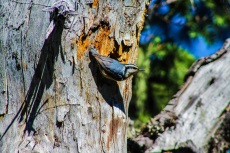
Red-breasted nuthatch. Photo credit: Jay Davis
Several songbirds frequent the Opal Creek Wilderness. The American dipper (Cinclus mexicanus) is the region’s only truly aquatic songbird, diving in and out of the rushing waters of Opal Creek streams in search of insect larvae. The varied thrush (Ixoreus naevius) may be seen on the forest floor searching for food, though it is more commonly heard; the male’s long, piercing whistle is often mistaken for a person. Like the American dipper, the varied thrush remains all year, foraging for berries and seeds in the winter and insects in the summer.
Summertime brings more songbirds to our forests. You are more likely to hear the sweet upward trill of the Swainson’s thrush (Catharus ustulatus) than to see it. Two species of hummingbird can be found whirring among wildflowers: the Rufous hummingbird (Selasphorus rufus) and Anna’s hummingbird (Calypte anna). On summer evenings, the common nighthawk (Chordeiles minor) flies above Sacred Rock hunting insects, creating a whooshing noise as air passes its wings on long dives.
Woodpecker holes can be found on many standing dead trees along the Opal Creek trails. Woodpeckers excavate these cavities in search of carpenter ants and other insects, and the holes they leave behind serve as habitat for many other species of birds and mammals. Common woodpeckers of Opal Creek are the Northern flicker (Colaptes auratus), red-breasted sapsucker (Sphyrapicus ruber), and pileated woodpecker (Hylatomus pileatus). The pileated woodpecker is the largest and most striking, with a flaming red crest and black and white stripes down its neck. Look for its distinctive large rectangular holes in dead trees.
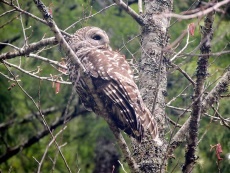
This owl, seen in 2014, was tentatively identified as a hybrid sparred owl. Photo credit: Mark Keating
Perhaps the most famous bird of Opal Creek is the Northern spotted owl (Strix occidentalis). The discovery of spotted owls in Opal Creek forests was a driving force behind the area’s designation as a wilderness in 1996. The spotted owl is old-growth dependent, nesting in the tops of standing dead trees or large living trees with broken tops. It feeds on small rodents, and even other old-growth dependent-species like the Humboldt's flying squirrel and the red tree vole (Arborimus longicaudus). Though its habitat has been preserved within Opal Creek, the spotted owl faces a new competitor in the barred owl (Strix varia), which is spreading from eastern forests and swamps into Pacific Northwest forests. In addition to out-competing the spotted owls, barred owls have been known to cross-breed with spotted owls, creating a hybrid species known as the “sparred owl.”
Amphibians
Amphibians are a class of animals with nearly 6,000 species worldwide. At Opal Creek, as in all temperate areas, we have two orders of amphibians: Anura (frogs and toads) and Caudata (salamanders). The amphibians of Opal Creek are a diverse group of no fewer than 13 species.
These animals can be found anywhere they can stay moist; inside of large logs, under rocks and bark, in lakes, streams, ponds, and puddles, and even in trees and snags. Many amphibians breathe through their skin, so any pollutants in the surrounding air or water are quickly absorbed into their bodies. One example, the Cascade torrent salamander (Ryacotriton cascadae), breathes primarily through its skin and has very reduced lungs. The presence of sensitive species like the Cascade torrent salamander in Opal Creek streams indicates the pristine water quality in our uncut watershed.
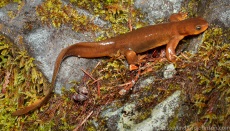
Rough-skinned newt. Photo credit: Steven Johnson
The most commonly-sighted, and most toxic, amphibian of Opal Creek is the rough-skinned newt (Taricha granulosa). It is easily identifiable by its rough-looking brown skin and its bright orange underbelly. Rough-skinned newts fear few predators because they can secrete a potent neurotoxin, known as tetrodotoxin, through their skin. Tetrodotoxin cannot be absorbed through your skin, but if ingested can cause sickness or even death! The only predator that has developed resistance to this toxin is the common garter snake (Thamnophis sirtalis), also abundant at Opal Creek.
Species List
Click here to download a comprehensive list of flora and fauna species found at Opal Creek (PDF).



